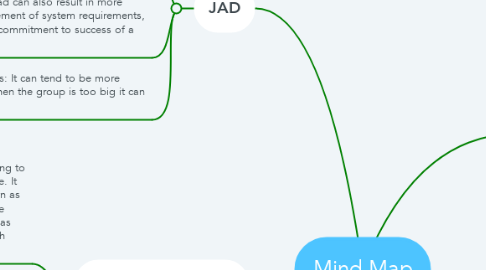Mind Map
by Megan Sakocius

1. JAD
1.1. Process: is a collaborative process, because it involves the end user to help through the development and design through JAD sessions
1.2. Advantages: It allows key users to participate. Jad can also result in more accurate statement of system requirements, has a strong commitment to success of a new system.
1.3. Disadvantages: It can tend to be more expensive. When the group is too big it can get difficult.
2. Agile Development
2.1. Process: This assists teams in responding to unpredictability of constructing software. It uses incremental work sequences known as sprints. Small releases with each release builds on the previous function as well as each release is throughly tested for high quality.
2.2. Advantages: It is a working software is delivered by weeks rather than months. Late changes in requirements are welcomed.
2.3. Disadvantages: Lack of emphasis on designing and documenting. The project can easily get off track for the user is not clear on what they want the final outcome to be.
3. SDLC
3.1. Process:This is the waterfall approach. Eat phase must be completed before the next phase can begin. There are 5 steps: Planning, Analysis, design, implementation, testing, and maintenance.
3.2. advantages: The shorter iteration, the easier testing/debugging will be. Also its easier to control because high risk task are completed before the next phase.
3.3. Disadvantages: It is bad for small projects, the whole process sometimes can be hard to manage.
4. RAD
4.1. Process: Is a team-based technique that speeds up info systems development. The process continues until the system is completely developed and users are happy. RAD has four main phases: requirements/planning, User design tasks, Construction tasks, Cutover Tasks.
4.2. Advantages: Systems can be developed quicker and cheaper.
4.3. Disadvantages: Allows less time to develop quality and consistency


